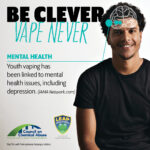Tobacco use is the leading cause of preventable death, disease and disability in the United States, according to the Centers for Disease Control and Prevention. More than 480,000 people die every year as a result of tobacco use or exposure to secondhand smoke, and every day, about 1,600 young people under 18 smoke their first cigarette.
In 2020, an estimated 30.8 million American adults smoked cigarettes, and more than 16 million were living with a smoking-related disease.
We offer FREE tobacco cessation classes that provide participants with support and free nicotine replacement patches, gum & lozenges. Register for a class today!

Our Be Clever Vape Never media campaign is aimed at educating teens about the risks of vaping. See our Be Clever Vape Never webpage.
Most regular tobacco users, including those who smoke traditional and e-cigarettes, are addicted to nicotine. According to the National Institute on Drug Abuse, “Addiction is characterized by compulsive drug-seeking and use, even in the face of negative health consequences.”
When cigarette smoke enters the lungs, nicotine is absorbed rapidly into the bloodstream. This sends a quick surge of endorphins to the brain, which peaks in 10 seconds. For many tobacco users, repeated exposure alters the brain’s sensitivity to dopamine and eventually leads to addiction.
Tobacco users need to continue smoking in order to maintain the pleasurable effects of nicotine and prevent withdrawal symptoms. These symptoms can include:
The first step to quitting is to become informed of the various ways to quit, while also exploring all the benefits. Once your research has been completed, devise a quit plan that is suited for you and your individual needs. Every tobacco user is different, and unfortunately, there is no magic cure to quit. Quitting may take numerous attempts, but the better prepared you are, the more successful your quit attempt will be.
A tobacco user has the absolute best chances of quitting when combing nicotine replacement therapy (NRT) with a smoking cessation program.
Sign up for a FREE tobacco cessation classes with COCA. Classes are offered at multiple locations in Berks County and participants receive NRT.
Family and friends often try to encourage a loved one to quit smoking by citing negative consequences of tobacco use. However, people who quit successfully are usually self-motivated. Therefore, the best tactic for family members is to offer support when someone decides to quit. For many users, quitting takes multiple attempts and relapses before kicking the habit for good.
As a friend or family member, it is important to educate yourself on tobacco products, nicotine addiction, and second-hand smoke. The more you understand about this addiction, the more supportive you can be.
Hotlines
Internet Resources